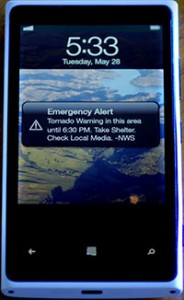Wireless Emergency Alerts
 The Wireless Emergency Alert (WEA) system is a public safety system in the United States that allows government agencies to send emergency messages to wireless devices in specific geographic areas. The system was created to provide timely and accurate information to the public during emergencies, including natural disasters, terrorist threats, and other types of public safety incidents.
The Wireless Emergency Alert (WEA) system is a public safety system in the United States that allows government agencies to send emergency messages to wireless devices in specific geographic areas. The system was created to provide timely and accurate information to the public during emergencies, including natural disasters, terrorist threats, and other types of public safety incidents.
The WEA system was established in 2006 as part of the Warning, Alert, and Response Network (WARN) Act, which directed the Federal Communications Commission (FCC) to develop regulations for a nationwide alert system that would use commercial mobile service providers to send emergency messages to the public. The system officially launched in 2012 and has since been used to send alerts to the public during a variety of emergencies.
The WEA system operates using a technology called Cell Broadcast, which allows messages to be sent to all wireless devices within a specific geographic area, regardless of whether the device is subscribed to a particular service provider or has a specific application running. This means that even if a person is visiting an area and does not have local service, they will still receive the emergency alert message.
WEA messages are limited to between 90 and 360 characters (depending on several factors) and can include information such as the type of emergency, the affected area, and any actions that people should take to stay safe. The messages are sent by authorized government agencies, including the Federal Emergency Management Agency (FEMA), the National Weather Service (NWS), and state and local emergency management agencies.
There are four types of WEA alerts: Presidential Alerts, Imminent Threat Alerts, Public Safety Alerts and AMBER Alerts. Presidential Alerts are sent by the President of the United States and are used to alert the public to national emergencies, such as terrorist attacks or natural disasters. Imminent Threat Alerts are used to warn the public of immediate threats to their safety, such as a tornado or a chemical spill. Public Safety Alerts contain information about a threat that may not be imminent or after an imminent threat has occurred. AMBER Alerts are used to notify the public of a missing child, and can include information about the child and any suspect or vehicle associated with the abduction.
While the WEA system has been successful in providing timely and accurate information to the public during emergencies, there have been some concerns about the system’s effectiveness and potential for false alarms. In 2018, a false alert was sent to residents of Hawaii warning of an imminent missile strike, causing widespread panic and confusion. The incident highlighted the need for improved protocols and procedures to prevent false alerts from being sent in the future.
Despite these concerns, the WEA system remains an important tool for public safety officials to communicate with the public during emergencies. The system has been used to provide critical information to the public during hurricanes, wildfires, and other natural disasters, helping to save lives and protect property. As technology continues to evolve, the WEA system will likely continue to be updated and improved to better serve the public’s needs during emergencies.
WEA is complementary to the County’s Community Notification System and does not replace it as they both have weaknesses and strengths requiring the use of both depending on the incident and intended audience.
Learn more about public alerting at: https://www.readygallatin.com/public-warning/emergency-alert-system/.




